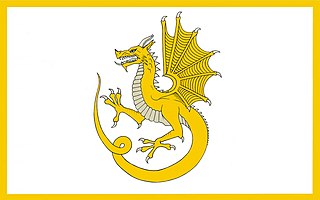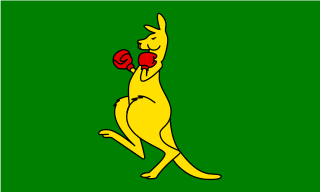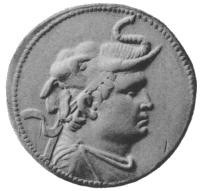
Kangaroos are marsupials from the family Macropodidae. In common use the term is used to describe the largest species from this family, the red kangaroo, as well as the antilopine kangaroo, eastern grey kangaroo, and western grey kangaroo. Kangaroos are indigenous to Australia and New Guinea. The Australian government estimates that 42.8 million kangaroos lived within the commercial harvest areas of Australia in 2019, down from 53.2 million in 2013.

A mascot is any human, animal, or object thought to bring luck, or anything used to represent a group with a common public identity, such as a school, sports team, society, military unit, or brand name. Mascots are also used as fictional, representative spokespeople for consumer products.

The wyvern is a type of mythical dragon with two legs, two wings, and often a pointed tail which is said to be a venomous stinger.

The maple leaf is the characteristic leaf of the maple tree. It is most widely recognized as the national symbol of Canada.

The coat of arms of Australia, officially the Commonwealth Coat of Arms, is a formal symbol of the Commonwealth of Australia. It depicts a shield, containing symbols of Australia's six states, and is held up by native Australian animals, the kangaroo and the emu. The seven-pointed Commonwealth Star surmounting the crest also represents the states and territories, while golden wattle, the national floral emblem, appears below the shield.

The Australia national rugby union team, nicknamed the Wallabies, is the representative national team in the sport of rugby union for the nation of Australia. The team first played at Sydney in 1899, winning their first test match against the touring British Isles team.

The boxing kangaroo is a national symbol of Australia, frequently seen in pop culture. The symbol is often displayed prominently by Australian spectators at sporting events, such as at cricket, tennis, basketball and football matches, and at the Commonwealth and Olympic Games. The flag is also highly associated with its namesake national rugby league team – the Kangaroos. A distinctive flag featuring the symbol has since been considered Australia's sporting flag.
The double-headed eagle is an iconographic symbol originating in the Bronze Age. A heraldic charge, it is used with the concept of an empire. Most modern uses of the emblem are directly or indirectly associated with its use by the late Byzantine Empire, originally a dynastic emblem of the Palaiologoi. It was adopted during the Late Medieval to Early Modern period in the Holy Roman Empire, Albania and in Orthodox principalities, representing an augmentation of the (single-headed) eagle or Aquila associated with the Roman Empire. In a few places, among them the Holy Roman Empire and Russia, the motif was further augmented to create the less prominent triple-headed eagle.
In Australia, the national representative team of many sports has a nickname, used informally when referring to the team in the media or in conversation. These nicknames are typically derived from well-known symbols of Australia. Often the nickname is combined with that of a commercial sponsor, such as the "Qantas Wallabies" or the "Telstra Dolphins". Some names are a portmanteau word with second element -roo, from kangaroo; such as "Olyroos" for the Olympic association football team.

The national colours of Australia are green and gold. They were formally adopted by the Governor-General of Australia, Sir Ninian Stephen, on 19 April 1984 in the Commonwealth of Australia Gazette; on advice from Prime Minister Bob Hawke.
Australian rules football in Germany is currently played by six clubs within the Australian Football League of Germany (AFLG) the governing body. Three clubs run metro leagues. The Dresden Wolves compete in the CAAFL of the Czech Republic and some other formative clubs play on an ad hoc basis within Germany.

Cultural depictions of lions are known in countries of Afro-Eurasia. The lion has been an important symbol to humans for tens of thousands of years. The earliest graphic representations feature lions as organized hunters with great strength, strategies, and skills. In later depictions of human cultural ceremonies, lions were often used symbolically and may have played significant roles in magic, as deities or close association with deities, and served as intermediaries and clan identities.

Chickens have been widely used as national symbols, and as mascots for clubs, businesses, and other associations.

Koala emblems and popular culture deals with the uses which have been made of the image of the koala, such as coins, emblems, logos, mascots and in the naming of sports teams.

The coat of arms of Berlin is used by the German city state as well as the city itself. Introduced in 1954 for West Berlin, it shows a black bear on a white shield. On top of the shield is a special crown, created by the amalgamation of the mural crown of a city with the so-called people's crown, used in Germany to denote a republic. Berlin's various boroughs use their own emblems.
The symbols of Queensland represent the Australian state of Queensland and the Queensland Government. The different symbols and emblems represent both the state and the government. The official state emblems of Queensland are prescribed in the Emblems of Queensland Act 2005.

Elephants have been depicted in mythology, symbolism and popular culture. They are both revered in religion and respected for their prowess in war. They also have negative connotations such as being a symbol for an unnecessary burden. Ever since the Stone Age, when elephants were represented by ancient petroglyphs and cave art, they have been portrayed in various forms of art, including pictures, sculptures, music, film, and even architecture.

At the 2010 Winter Paralympics in Vancouver, British Columbia, Canada, Australia sent 11 athletes to compete against the other participating 42 nations. The delegation consisted of 3 sighted guides and 17 support staff. This was the largest delegation Australia had sent to a Winter Paralympics. Australia has participated in every winter Paralympics since its conception.
Qantas is Australia's largest airline. Qantas was founded in Winton, Queensland, on 16 November 1920 as Queensland and Northern Territory Aerial Services Limited by Paul McGinness, Sir Hudson Fysh and Sir Fergus McMaster, the latter of whom was chairman. Arthur Baird was employed as a chief aircraft engineer. McGinness left QANTAS for other interests, and Hudson Fysh remained with the company as General Manager & Managing Director. He retired as Sir Hudson Fysh KBE DFC, Chairman of QANTAS in 1966.

The Golden Gate Roos are a United States Australian Football League team, based in San Francisco, California, United States. The team was founded in 1998. Its mascot is the Australian marsupial kangaroo adopting the nickname of the Kangaroos club in the Australian Football League. Golden Gate won the USAFL National Championship in 2017.
























